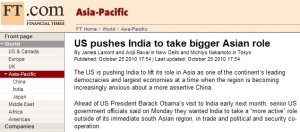中国にインドをぶつけろ、米国がいよいよ「バック・パッシング」発動か、それを煽る英国メディア ― 2010/10/26 09:13
こんな時こそ中国の下品な反日デモに熱くなってはいけない。今こそ世界を見渡そう。学ぶべきは英国。
先日、ツイッターで「中国に対して日本はでしゃばらない方がいいのに。米、印を表に立てて、その裏でコソコソ動く程度がよい」と呟いたのはこの私。
米国もしたたか。台頭する中国にインドをぶつけようとするはず。これぞ「バック・パッシング」。米国は責任を押し付ける側なので「バック・パッサー」、インドは責任を押し付けられる側なので「バック・キャッチャー」という構図。
インドはすでにやる気満々。米国も武器が売れて商売繁盛。その背後で当然英国の軍需産業も蠢いている。
米国の「バック・パッシング」発動を煽るかのような記事を掲載したのは英フィナンシャル・タイムズ紙。英エコノミスト誌と歩調を合わせながら、今度もまたうまい具合に米国を操ろうとしている。
絶好のビジネスチャンスを逃すものかと武器輸出三原則の見直しを進める日本。今ならまだなんとか間に合うが、民主党に決断できる人がいるのだろうか。
<関連記事引用>
US pushes India to take bigger Asian role (画像引用)
By James Lamont and Anjli Raval in New Delhi and Michiyo Nakamoto in Tokyo
Published: October 25 2010 17:54 | Last updated: October 25 2010 17:54
http://www.ft.com/cms/s/0/cbbdbc42-e056-11df-99a3-00144feabdc0.html
The US is pushing India to lift its role in Asia as one of the continent’s leading democracies and largest economies at a time when the region is becoming increasingly anxious about a more assertive China.
Ahead of US President Barack Obama’s visit to India early next month, senior US government officials said on Monday they wanted India to take a “more active” role outside of its immediate south Asian region, in trade and political and security co-operation.
“We view India as an east Asian power,” said one official. “India is not limited to the context of its immediate neighbourhood.”
India has so far not been included in emerging east Asian institutions, which loosely bind China, Japan and South Korea with south-east Asian nations and the US and Australia.
The US comments coincided with a visit by Manmohan Singh, India’s prime minister, to Japan on the first leg of a “Look East” tour that will also take him to Vietnam and Malaysia this week.
Mr Singh and Naoto Kan, Japan’s prime minister, concluded negotiations on a economic partnership agreement, paving the way for increased Japanese investment in the fast growing Indian economy.
Indian leaders have expressed fears the country is being hemmed in by Beijing’s expanding political and trade ties with Pakistan, Burma, Nepal and Sri Lanka.
“Certainly China is a topic of active discussion between our governments,” said a US official. “We don’t have identical concerns.”
New Delhi has also aired its worries about Washington’s relationship with Beijing. It was upset last year when a communiqué issued during Mr Obama’s visit to Beijing offered China a role in south Asia.
New Delhi is particularly sensitive about China’s ambitions in nuclear-armed Pakistan, its rising maritime might and border disputes in Arunachal Pradesh, India’s north-eastern state, and Kashmir.
US officials said inviting India to boost its role in Asia was not an attempt to rebalance Washington’s relationship with New Delhi and Beijing. But they said that India would have a larger part in Asian regional forums like the East Asia summit.
Although India is not expected to join the US as a defence ally, India has become the US’s most frequent military exercise partner, conducting 50 exercises over the past eight years. US officials are keen to develop the inter-operability of India’s military hardware to allow support in anti-piracy, peace-keeping and humanitarian operations.
The US describes its relationship with India as having transformed “exponentially” under the presidencies of Bill Clinton, George W. Bush and now Mr Obama.
India eyes $11bn US fighter jets
ByLionel Barber and James Lamont in New Delhi
Published: October 24 2010 21:22 | Last updated: October 24 2010 21:22
http://www.ft.com/cms/s/0/ee4c0a16-df9d-11df-bed9-00144feabdc0.html
India will turn increasingly to US defence products to secure its borders and wider interests, top Indian officials have said ahead of a visit by Barack Obama, US president, next month.
The desire for a closer defence partnership comes as New Delhi considers an $11bn deal to buy 126 multi-role combat fighter jets to rearm India’s out-of-date air force and boost defence capabilities against Pakistan and China.
Lockheed Martin and Boeing are among six foreign companies competing for the sale.
India is one of the world’s largest arms bazaars with a military budget of Rs1,420bn ($32bn). Mr Obama’s visit will be followed this year by those of Nicolas Sarkozy, France’s president, and Demetri Medvedev, Russia’s prime minister. Both would like to supply India.
The Indian army is the third largest in the world, with 1.1m soldiers in active service. India ranks third after Russia and China as one of the fastest growing defence spenders.
Top Indian officials say defence co-operation and the purchase of equipment is a key part of the strategic dialogue between New Delhi and Washington. They say their potential purchase of military equipment from the US is important for the American economy at a time when the administration needs to create jobs to overcome an unemployment crisis.
However, people familiar with the bidding process for the fighter jets say any decision is unlikely until mid-2011 and will in large part depend on sealed bids by the defence groups that will determine the price of any transaction.
In addition, the attractiveness of the US offers could be affected by India’s reluctance to sign technical agreements with the US that would allow transfer of navigation and targeting technology.
Some Indian officials have expressed misgivings about acquiring equipment that is “interoperable” with the US, for fear of aligning New Delhi too closely with Washington.
US defence sales to India have risen steadily, with Robert Gates, defence secretary, saying India’s decisions concern not just equipment but relations between the two countries.
Mr Obama is expected to conclude a deal to buy 10 C-17 transport aircraft from Boeing as part of a package worth as much as $3.5bn.
Last year, India agreed to buy eight long-range maritime reconnaissance aircraft from Boeing, its largest acquisition of military hardware from the US. The $2.1bn purchase of P-81 Poseidon aircraft highlighted the possibilities opened up by a civil nuclear deal that ended a cold war-era stand-off.
<関連記事>
英エコノミスト誌:衝突か協調か 中国とインド 世紀のライバル
http://y-sonoda.asablo.jp/blog/2010/08/23/5303264


最近のコメント